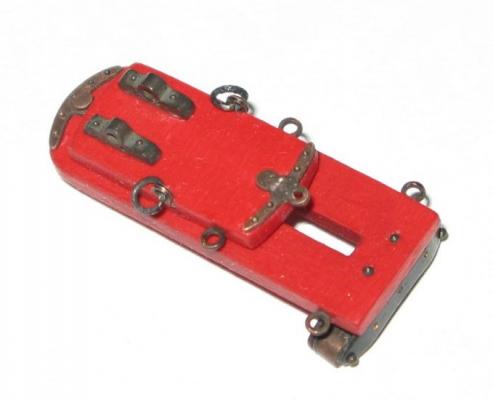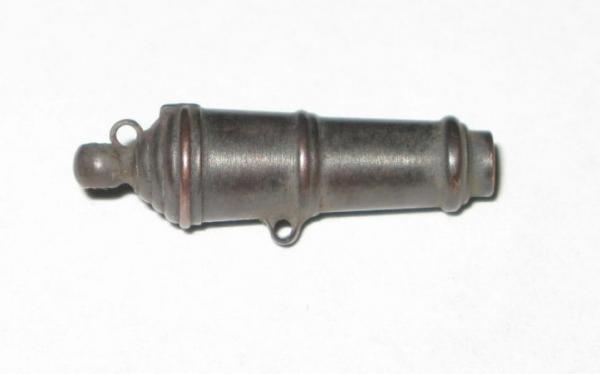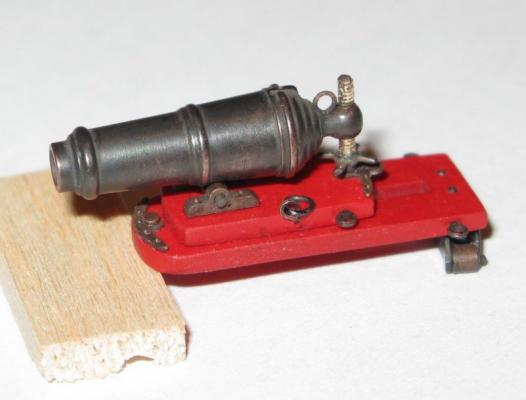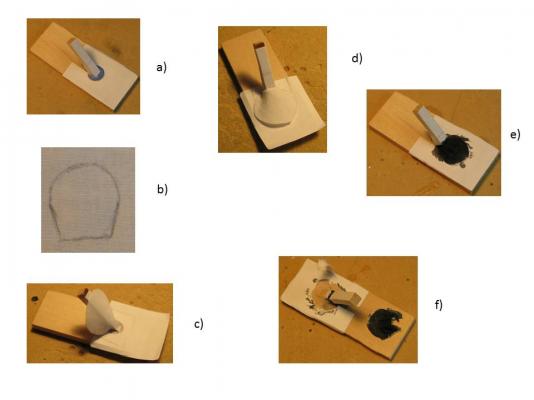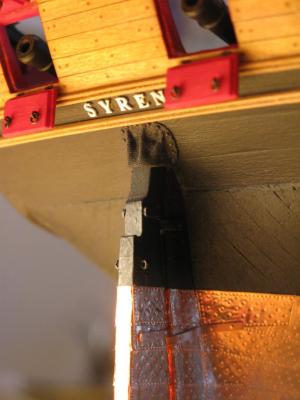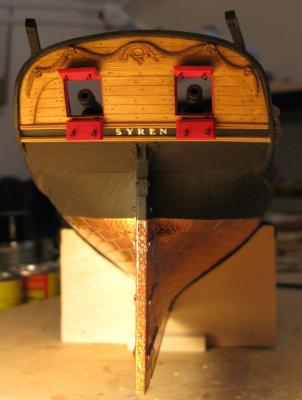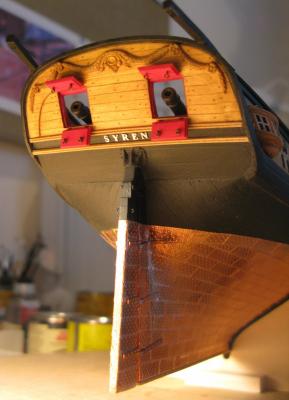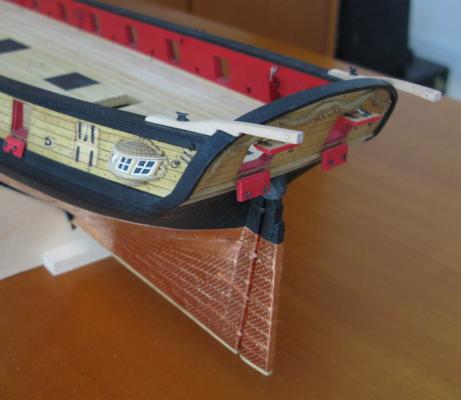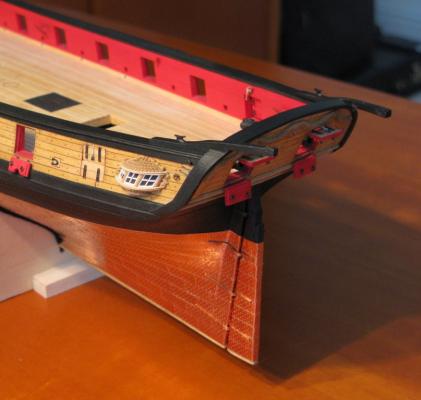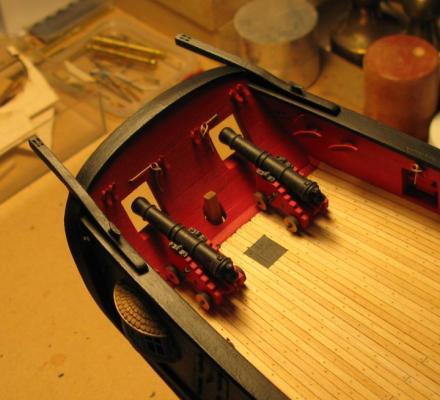-
Posts
1,217 -
Joined
-
Last visited
Content Type
Profiles
Forums
Gallery
Events
Everything posted by Gahm
-
Richard, I think you are off to a very good start! Thomas
- 227 replies
-
- syren
- model shipways
-
(and 1 more)
Tagged with:
-
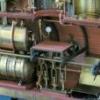
US Brig Syren by Gahm - Model Shipways
Gahm replied to Gahm's topic in - Kit build logs for subjects built from 1801 - 1850
Thank you for all the “likes” and your great feedback! As always it is most welcome and appreciated! Dirk – your guns set such a high standard that I am happy if I get somewhere close to your league Richard – detailing these carronades is not much different from making 120 beautiful hammocks . . . it just takes a lot of time, patience, and dedication to our hobby. Btw, you are most welcome to “steal” my rudder coat design . . . which I “stole” from a French ship model website (http://modelisme.arsenal.free.fr/artdumodelisme/La%20Belle%20Poule/indexgb.html) Bob – of course you are right . . . I could go with the current prototype. The problem is only that I have some ideas how to do it a bit better and I am just curious whether it will work and what the result will look like. So I better try it out . . . otherwise I always feel that I missed out on something Robert and Gerty – thank you for stopping by and for your nice compliments! Russ – as always I highly appreciate your feedback. And I love the sentence that comes with your contributions: “T’aint a hobby if you hurry”. I keep reminding myself of this sentence when I sometimes get frustrated with my “snail’s pace” progress Augie – thank you for your feedback. It is most valuable for me as I know it is coming from somebody who has already finished the Syren and has gone through all these steps. B.E. – the rudder coat is really easily underestimated. As I wrote in my log it took me several attempts to get something acceptable. So I am glad that someone with your modeling experience and craftsmanship likes the result! Thomas -

US Brig Syren by Gahm - Model Shipways
Gahm replied to Gahm's topic in - Kit build logs for subjects built from 1801 - 1850
A little update . . . just to show a sign of life . I spent some time figuring out how I want to do the carronades. The following 3 pictures show the current state of the prototype. Obvious points of improvement are the elevation screw (in the picture it is really “screwed” up), the wheels need to be a bit smaller, and the holder for the recoil cable on the gun barrel needs to be more substantial. For all of these issues I have ideas how to change them, but so far my chronic lack of modeling time prevented me from doing it. Thomas -
I agree with Richard, I could live in that cabin ! Thomas
- 2,191 replies
-
- confederacy
- Model Shipways
-
(and 1 more)
Tagged with:
-
Richard, your hammocks are a very nice touch to a beautiful model! Well done! Although I don't envy you doing another 119 of them Thomas
- 227 replies
-
- syren
- model shipways
-
(and 1 more)
Tagged with:
-
Bob, your Essex just looks terrific! I love to follow your build log! Thomas
- 1,477 replies
-
- essex
- model shipways
-
(and 1 more)
Tagged with:
-
Richard, great job on your Syren - as usual! Absolutely beautiful! And isn't it amazing how all these details add up ? Thomas
- 227 replies
-
- syren
- model shipways
-
(and 1 more)
Tagged with:
-
Fantastic floor! Well done! Thomas
- 2,191 replies
-
- confederacy
- Model Shipways
-
(and 1 more)
Tagged with:
-
They fit the wood carriage assembly from the Syren kit perfectly. Just buy the barrels - I think they come in pairs with the elevation screws included. If you buy the whole assembly including carriage it is getting quite expensive. The one thing you have to design yourself is the mounting mechanism between the barrel and the carriage. But the best reference there is Dirk's build log. He came up with a beautiful solution. Thomas
-
Your bricks look very realistic! Excellent job! Thomas
- 2,191 replies
-
- confederacy
- Model Shipways
-
(and 1 more)
Tagged with:
-
Fantastic job! Can't get enough of your pictures Thomas
- 1,477 replies
-
- essex
- model shipways
-
(and 1 more)
Tagged with:
-
Augie, I really like your gratings! It may be just perception, but on your image they look like they are made out of one piece?? Normally most gratings are made out of these "comb"- like parts which fit into each other and once assembled make out the grating. Did you use the same technique? Thomas
- 2,191 replies
-
- confederacy
- Model Shipways
-
(and 1 more)
Tagged with:
-
Jason, your Syren is really coming along very nicely! And I love your long guns! I just would check the middle part of your stern decoration again. I may be wrong but I always thought it should be mounted the other way round - flipped around by 180 degrees. Not that it would make a big difference. And as I never used these parts of the kit myself I may be completely wrong here, too Thomas
-
Beautiful work, Bob! And the amount of details you build into your Essex is just amazing! What diameter did you use for the anchor cable? Thomas
- 1,477 replies
-
- essex
- model shipways
-
(and 1 more)
Tagged with:
-
Richard, I never figured out what the brass nails are for. I don't think they are meant for the coppering jig, although you could probably use them for that. What you choose for your nail head depends on what pattern you want to create. If you look at the different Syren build logs you will see all kinds of suggestions on how to do that and what to use. I went with a pretty fine "in scale" nail pattern. For that I bought me some diabetes needles (diameter less than 0.5 mm - you can get a nice selection of various brands at pretty much any pharmacy store including Walmart for very little money) and built my nail head using a bunch of those needles. If you want to go with a coarser pattern as most Syren modelers do any types of nails with the diameter of your choice will do. Thomas
-
Bob, I just discovered your Fair American build log. This is one beautiful model! And your planking is absolutely superb! But what totally amazes me is your combination of highest quality and productivity. You must average at least one complex model per year! How can that be achieved? It takes me about 10 times that long! Thomas
-

US Brig Syren by Gahm - Model Shipways
Gahm replied to Gahm's topic in - Kit build logs for subjects built from 1801 - 1850
Thank you Russ! This piece was quite a bit more challenging than I initially anticipated. I had several tries, each of them turned out to be either too tight, too big, too clumsy looking, . . . I finally settled for the one which you see in the images. The rudder coat is not really difficult from a technical point of view, it is more to get the details right such as an "in scale" texture, the size, tightness versus a number of of well placed wrinkles . . . Floyd, for the material I just had a close look at everything made of cloth, preferably cotton, in our household to identify something with the right texture (obviously there were certain pieces I stayed away from such as my wife's dresses ). You can find ribbons for presents with all kinds of very interesting textures. I finally settled on an old handkerchief made of pretty fine cotton which has not seen any use since the invention of the paper tissue . I cut out the right shape as shown in the picture (1b), mounted it on the jig and gave it the right shape by gluing it to the paper coat of the jig (1c,d). The paper itself was only glued to the jig at the very edges (1a), so that it was nicely fixed to the jig, but was not glued to it in the area where the cotton was attached to the paper. In that way you can later easily remove the rudder coat from the jig with the paper still sticking to the cotton, and together with the glue preserving its shape. I soaked the whole arrangement two times with highly diluted black paint (1e, ModelExpo Black). Once dry the rudder coat was removed from the jig (1f), cut into its final shape with a scissors, and mounted on the Syren. After some touch up the nails were finally inserted. The nails were from Scale Hardware, 0.7mm nail head diameter. -

US Brig Syren 1803 by danri - Scale 1:64
Gahm replied to danri's topic in - Build logs for subjects built 1801 - 1850
Beautiful model! Very well done. Thanks for sharing! Thomas -

US Brig Syren by Gahm - Model Shipways
Gahm replied to Gahm's topic in - Kit build logs for subjects built from 1801 - 1850
I finished another little detail - the rudder coat. Image one shows the jig and process which I used to make this piece. The finished rudder coat mounted on the stern of the Syren model can be seen in images 2, 3 and 4. Thomas Image 1 Jig and process for making the rudder coat Image 2 Image 3 Image 4 -
Richard, having gone through the construction of the stern davits myself just recently I know exactly what you are talking about! These guys can be a little bit tricky. But yours turned out beautifully! And I fully agree with Floyd, you have a very good way of making the metal cast parts look like wood. Your stern decoration is very well done! Thomas
- 227 replies
-
- syren
- model shipways
-
(and 1 more)
Tagged with:
-

US Brig Syren by Gahm - Model Shipways
Gahm replied to Gahm's topic in - Kit build logs for subjects built from 1801 - 1850
Russ, Bob, Augie, Richard: Thank you for your kind comments! They are always highly appreciated! I was kind of surprised myself to get something finished in such a "short" time frame. I almost forgot how that felt Thomas -

US Brig Syren by Gahm - Model Shipways
Gahm replied to Gahm's topic in - Kit build logs for subjects built from 1801 - 1850
I finished the stern davits. I made them out of pear wood (image 1) and mounted them (image 2) by notching the davits (and not the stern). I felt it would be easier to recover from potential mistakes using this method. Images 3 and 4 show the davits in their final position. Thomas Image 1 Image 2 Image 3 Image 4
About us
Modelshipworld - Advancing Ship Modeling through Research
SSL Secured
Your security is important for us so this Website is SSL-Secured
NRG Mailing Address
Nautical Research Guild
237 South Lincoln Street
Westmont IL, 60559-1917
Model Ship World ® and the MSW logo are Registered Trademarks, and belong to the Nautical Research Guild (United States Patent and Trademark Office: No. 6,929,264 & No. 6,929,274, registered Dec. 20, 2022)
Helpful Links
About the NRG
If you enjoy building ship models that are historically accurate as well as beautiful, then The Nautical Research Guild (NRG) is just right for you.
The Guild is a non-profit educational organization whose mission is to “Advance Ship Modeling Through Research”. We provide support to our members in their efforts to raise the quality of their model ships.
The Nautical Research Guild has published our world-renowned quarterly magazine, The Nautical Research Journal, since 1955. The pages of the Journal are full of articles by accomplished ship modelers who show you how they create those exquisite details on their models, and by maritime historians who show you the correct details to build. The Journal is available in both print and digital editions. Go to the NRG web site (www.thenrg.org) to download a complimentary digital copy of the Journal. The NRG also publishes plan sets, books and compilations of back issues of the Journal and the former Ships in Scale and Model Ship Builder magazines.



